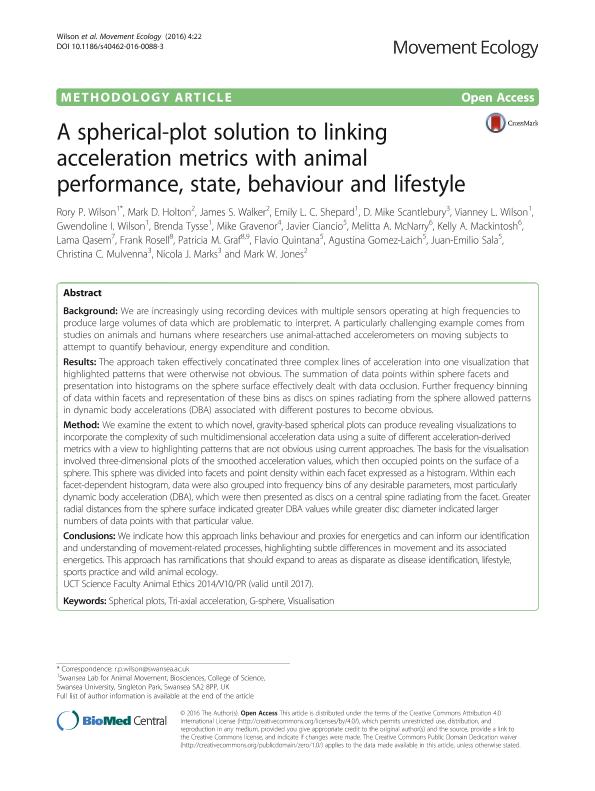Artículo
A spherical-plot solution to linking acceleration metrics with animal performance, state, behaviour and lifestyle
Wilson, Rory P.; Holton, Mark D.; Walker, James; Shepard, Emily L. C.; Scantlebury, D. Mike; Wilson, Vianney L.; Wilson, Gwendoline I.; Tysse, Brenda; Gravenor, Mike; Ciancio Blanc, Javier Ernesto ; McNarry, Melitta A.; Mackintosh, Kelly A.; Qasem, Lama; Rosell, Frank; Graf, Patricia M.; Quintana, Flavio Roberto
; McNarry, Melitta A.; Mackintosh, Kelly A.; Qasem, Lama; Rosell, Frank; Graf, Patricia M.; Quintana, Flavio Roberto ; Gómez Laich, Agustina Marta
; Gómez Laich, Agustina Marta ; Sala, Juan Emilio
; Sala, Juan Emilio ; Mulvenna, Christina C.; Marks, Nicola J.; Jones, Mark W.
; Mulvenna, Christina C.; Marks, Nicola J.; Jones, Mark W.
 ; McNarry, Melitta A.; Mackintosh, Kelly A.; Qasem, Lama; Rosell, Frank; Graf, Patricia M.; Quintana, Flavio Roberto
; McNarry, Melitta A.; Mackintosh, Kelly A.; Qasem, Lama; Rosell, Frank; Graf, Patricia M.; Quintana, Flavio Roberto ; Gómez Laich, Agustina Marta
; Gómez Laich, Agustina Marta ; Sala, Juan Emilio
; Sala, Juan Emilio ; Mulvenna, Christina C.; Marks, Nicola J.; Jones, Mark W.
; Mulvenna, Christina C.; Marks, Nicola J.; Jones, Mark W.
Fecha de publicación:
09/2016
Editorial:
BioMed Central Ltd.
Revista:
Movement Ecology
ISSN:
2051-3933
Idioma:
Inglés
Tipo de recurso:
Artículo publicado
Clasificación temática:
Resumen
Background: We are increasingly using recording devices with multiple sensors operating at high frequencies to produce large volumes of data which are problematic to interpret. A particularly challenging example comes from studies on animals and humans where researchers use animal-attached accelerometers on moving subjects to attempt to quantify behaviour, energy expenditure and condition. Results: The approach taken effectively concatinated three complex lines of acceleration into one visualization that highlighted patterns that were otherwise not obvious. The summation of data points within sphere facets and presentation into histograms on the sphere surface effectively dealt with data occlusion. Further frequency binning of data within facets and representation of these bins as discs on spines radiating from the sphere allowed patterns in dynamic body accelerations (DBA) associated with different postures to become obvious. Method: We examine the extent to which novel, gravity-based spherical plots can produce revealing visualizations to incorporate the complexity of such multidimensional acceleration data using a suite of different acceleration-derived metrics with a view to highlighting patterns that are not obvious using current approaches. The basis for the visualisation involved three-dimensional plots of the smoothed acceleration values, which then occupied points on the surface of a sphere. This sphere was divided into facets and point density within each facet expressed as a histogram. Within each facet-dependent histogram, data were also grouped into frequency bins of any desirable parameters, most particularly dynamic body acceleration (DBA), which were then presented as discs on a central spine radiating from the facet. Greater radial distances from the sphere surface indicated greater DBA values while greater disc diameter indicated larger numbers of data points with that particular value. Conclusions: We indicate how this approach links behaviour and proxies for energetics and can inform our identification and understanding of movement-related processes, highlighting subtle differences in movement and its associated energetics. This approach has ramifications that should expand to areas as disparate as disease identification, lifestyle, sports practice and wild animal ecology. UCT Science Faculty Animal Ethics 2014/V10/PR (valid until 2017).
Palabras clave:
G-SPHERE
,
SPHERICAL PLOTS
,
TRI-AXIAL ACCELERATION
,
VISUALISATION
Archivos asociados
Licencia
Identificadores
Colecciones
Articulos(IBIOMAR)
Articulos de INSTITUTO DE BIOLOGIA DE ORGANISMOS MARINOS
Articulos de INSTITUTO DE BIOLOGIA DE ORGANISMOS MARINOS
Citación
Wilson, Rory P.; Holton, Mark D.; Walker, James; Shepard, Emily L. C.; Scantlebury, D. Mike; et al.; A spherical-plot solution to linking acceleration metrics with animal performance, state, behaviour and lifestyle; BioMed Central Ltd.; Movement Ecology; 4; 22; 9-2016; 1-11
Compartir
Altmétricas



